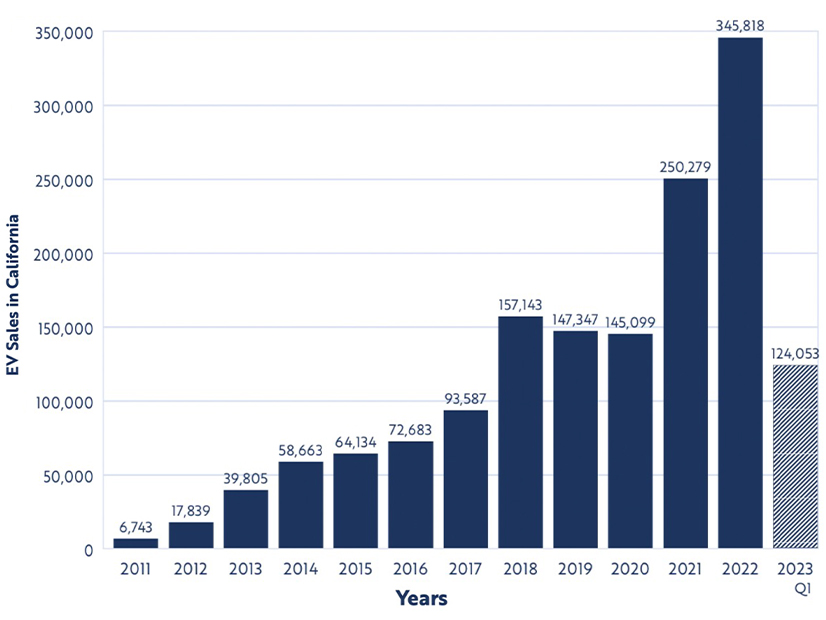More than 1.5 million light-duty electric vehicles have now been sold in California, beating by two years the target set by a governor’s executive order in 2012.
The state reached the 1.5-million EV milestone during the first quarter of this year, according to data released Thursday by the California Energy Commission. And 21% of new cars sold in California in the first quarter were electric. The EV data include battery electric vehicles, plug-in hybrids and hydrogen fuel cell EVs.
In March 2012, Gov. Jerry Brown issued executive order B-16-2012, calling for 1.5 million zero-emission vehicles on California roads by 2025.
At the time, many viewed the target as a “moonshot,” or aspirational goal, state officials said during a media briefing on Thursday. At the end of 2011, only 6,743 EVs had been sold in the state.
“When Gov. Brown set this goal, people across the state and around the nation said it couldn’t be done,” said Lauren Sanchez, senior climate adviser to Gov. Gavin Newsom. “But here in California, we make the future happen. We don’t just set goals, we achieve them.”
California Air Resources Board Chair Liane Randolph credited the state’s zero-emission vehicle (ZEV) regulations for spurring ZEV technology and manufacturing.
“The industry has responded incredibly rapidly to the confluence of market pressures, consumer demands and regulatory requirements,” Randolph said during the briefing.
In 2012, CARB adopted its initial Advanced Clean Cars regulation, which requires an increasing percentage of zero-emission cars to be sold each year. In August, the agency adopted Advanced Clean Cars II, which requires all new cars sold in the state to be zero-emission or plug-in hybrid by 2035. (See Calif. Adopts Rule Banning Gas-powered Car Sales in 2035.)
ZEV adoption in California also has been boosted by nearly $2 billion in purchase incentives, officials said.
“California is setting the bar for climate action,” Newsom said in a statement. “And we’re achieving our goals years ahead of schedule thanks to unprecedented investments secured in partnership with the Legislature.”
The 1.52 million light-duty EVs sold in California through the end of the first quarter of 2023 represent 42% of the 3.61 million EVs sold in the U.S.
“The transition to ZEVs is here, and it’s happening quickly,” California Energy Commission member Patty Monahan said during Thursday’s media briefing.
The CEC is playing a lead role in ensuring enough charging infrastructure and hydrogen-fueling stations are built to support the growing number of EVs. A 2021 analysis found that the state will need 1.2 million public and shared private charging ports to support 8 million plug-in electric passenger vehicles in 2030, Monahan said. The CEC expects to release this year an updated analysis of EV charger demand.
According to figures released Thursday, California had 87,707 EV chargers and 63 hydrogen-fueling stations at the end of the first quarter.
Monahan said efforts are also underway to improve the reliability of public chargers. Drivers often find that chargers don’t work at the public stations, or there’s a glitch in using their credit cards, she said. CEC is developing reporting requirements for the reliability of publicly funded chargers and will publish a report on the reliability of the state’s EV charging network.
In addition, Monahan said, EVs must be “good citizens of the grid.” An analysis found that EVs will account for less than 5% of peak load in 2030. But that demand must be managed wisely, she added.
“With the right incentives, vehicles could shift charging from peak times to the middle of the day,” Monahan said. “You could literally run your vehicle on sunshine, and we wouldn’t have to curtail renewable energy.”



